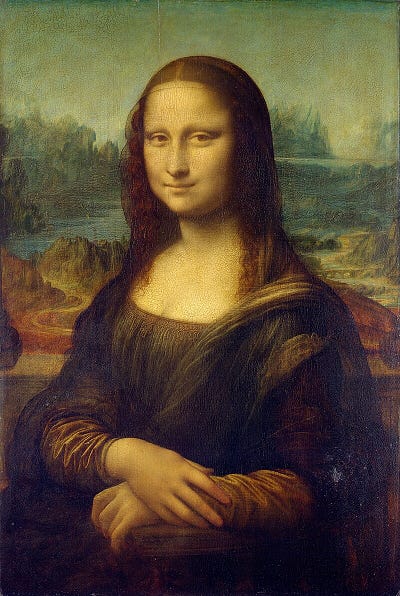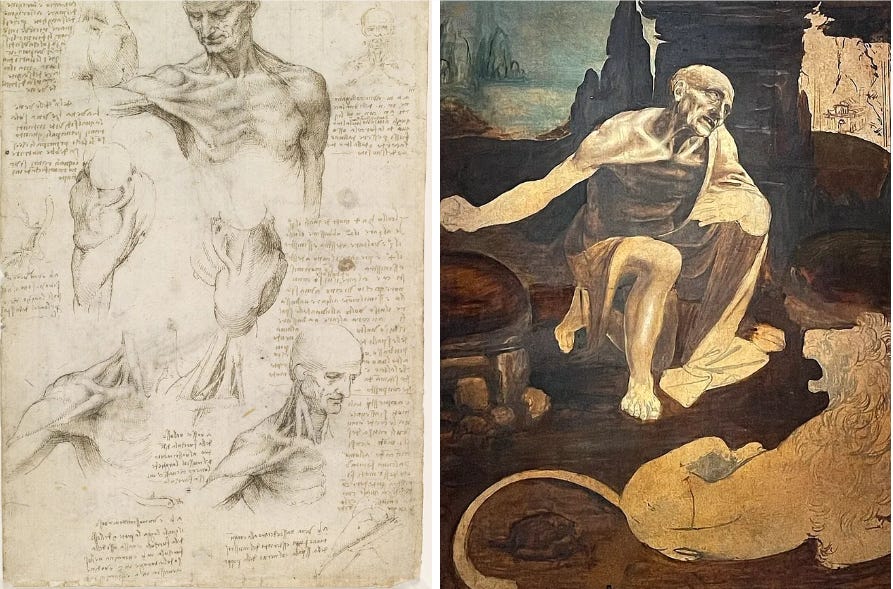The Secret Da Vinci Learned About Nature After Years Of Self Study
Centuries later science codified his beliefs

The portrait above might be the most famous painting in the world. It’s also emblematic of its creator. Leonardo Da Vinci made few paintings and often never finished the ones he started.
The Mona Lisa technically isn’t complete either. Da Vinci never delivered it to the patron that commissioned it, and continued working on it intermittently until the day he died.
This may appear to be bad form for a painter. But Da Vinci wasn’t just a painter; this method of art was only one of the tools he used to understand the world. His ultimate superpower was an unsettled curiosity.
In Ken Burns’s documentary Leonardo da Vinci, the filmmaker reveals this artist didn’t go to college or search for wisdom in books. He looked for it in nature.
Burns says of Da Vinci:
“Real knowledge he believed was found in nature, and best gained through observation and experience.”
Da Vinci did this with notes and drawings. It’s thought he wrote over 28,000 pages of notes, of which only a quarter survive today. These writings cover mathematics, painting, engineering, flight, biology, anatomy, and science.
Throughout his apprenticeship with nature, Da Vinci began to see the outline of a greater idea that spread across all domains — a certain pattern. Burn’s documentary refers to it as a comparison of the microcosm and macrocosm (or smaller internals versus larger externals).
Da Vinci could see these patterns repeated throughout the natural features of the earth, the animals on it, within our bodies, and the branches of trees. Centuries later, aided by computers, scientists hammered Da Vinci’s hunch into a mathematical formula. It even got its own field of study.
But before we get to this final revelation, we must understand Da Vinci.
The Power Of An Artist’s Eye Applied To Science
Leonardo was born in Vinci, in the Republic of Florence in 1452, to parents that weren’t married. His father was a wealthy notary and landlord, while his mother was a peasant. But Burns points out in his documentary that Leonardo’s illegitimate status was just a slight hinderance.
The only thing an illegitimate child in Italy of this day couldn’t do, was go to college. Leonardo still received an elementary education in reading, writing, and arithmetic. His father’s status also got the boy an apprenticeship at the workshop of Andrea del Verrocchio, a renowned painter and sculptor at the age of fifteen.
He remained working with Verrocchio for about ten years, picking up artistic and mechanical skills.
Leonardo spent the rest of his life traveling between Florence, Milan, Rome, and France searching for patrons to support himself and a small stable of assistants. During this time, his curiosity only grew.
In his first stint in Milan (1482–1499), Leonardo began taking notes on anything he observed and came to a realization. Artists have a unique power, as the Encyclopedia Britannica eloquently summarizes:
“The painter, doubly endowed with subtle powers of perception and the complete ability to pictorialize them, was the person best qualified to achieve true knowledge, as he could closely observe and then carefully reproduce the world around him. Hence, Leonardo conceived the staggering plan of observing all objects in the visible world, recognizing their form and structure, and pictorially describing them exactly as they are.”
So, Leonardo’s notes grew, but his skills as an artist made them truly unique. While he was adept with words, illustrations took a prime feature within his writings. Text was just there to explain the drawings.
Over time, these notes turned into over forty codices on painting, architecture, mechanics (including flight), and anatomy. Burns even points out that Da Vinci’s mechanical notes have the first instance of an exploded diagram of a machine. But these paled in comparison to his work on anatomy.

Leonardo became a master at replicating the human body because he spent so much time taking it apart and examining it. A quick look at St. Jerome’s neck and shoulder proves this. The American Journal of Cardiology explains between 1489 and 1513, the artist dissected at least thirty bodies.
Burns says one of these bodies was of an old man, who claimed to be a hundred years old, that passed away peacefully.
Da Vinci noted the walls of his arteries had become thick, which would obstruct the movement of blood. He knew this from river engineering. If a river became silted, it slowed the movement of water, like clogged arteries would do for blood. It was the first diagnosis of coronary atherosclerosis (or buildup of plaque in the arteries) in the world.

He also noticed how the arteries, lungs, and veins took shapes like tree branches. Da Vinci had also previously noticed similar design structures between humans and animals, long before Darwin proposed the theory of evolution.
Da Vinci even made sketches of a cow heart pumping blood so detailed, a heart surgeon from the UK used them in 2005 to develop a new method to repair heart valves.
The artist’s never-ending research caused him to see similarities within nature, the human body, and the earth itself. Moreover, these patterns appeared everywhere. Centuries later, science would catch up to Da Vinci’s observations and put a name to it.
Patterns And An Equation
“As early as the 16th century, Leonardo da Vinci provided a comparative study that envisioned how arteries and veins might grow. In this view, the growth of tree-like structures starts with a main stem, from which a sprout emerges that would subsequently grow out into a branch that is smaller than the parental stem, followed by multiple iterations. This mode of branching morphogenesis applies to the tracheal system of drosophila, the mammalian lung, and kidney. It also operates in many settings within newly forming blood vessels.”
— Red-Horse K, Siekmann AF. Veins and Arteries Build Hierarchical Branching Patterns Differently: Bottom-Up versus Top-Down. Bioessays. 2019 Mar;41(3)
While Alan Turing’s name may be synonymous with breaking German coding devices and the Turing Test for spotting AI, these weren’t his only breakthroughs. Turing also figured out the puzzle on how cells develop. He called it morphogenisis.
Simply put, all cells within an early embryo are all the same, but over time develop into other things. For instance, some become skin cells, others eyes, bones, and the like. This seemingly happens with no direction. But how?
Well, Turing used equations generally used in physics to describe biological processes in his 1952 paper The Chemical Basis of Morphogenesis.
Here the scientist used math to explain natural patterns, like stripes, spirals, and even the spots on a cow’s skin.
These self-organizing patterns happen by chemicals moving across cells, much like wind scattering sand into a certain pattern.
At the same time, a Soviet chemist named Boris Belousov mixed various chemicals in a petri dish and they changed color. This was no big surprise. However, Belousov was shocked when they suddenly changed back. Not only did they change back, but formed random patterns in the chemicals. This is now known as the Belousov-Zhabotinsky Oscillating Reaction.
This study of patterns in nature foreshadows the work of a future mathematician named Benoit Mandelbrot. Like Turing and Belousov, he was very interested in patterns. Mandelbrot moved from academia to working with IBM in 1958, just so he could harness the power of their computers.
These machines showed Mandelbrot that patterns existed everywhere, even in things we think are random. He coined a term “fractal,” that developed into a new type of geometry.
The Encyclopedia Britannica defines fractal (geometry) as:
“Fractals possess the property of self-similarity…A self-similar object is one whose component parts resemble the whole. This reiteration of details or patterns occurs at progressively smaller scales and can, in the case of purely abstract entities, continue indefinitely, so that each part of each part, when magnified, will look basically like a fixed part of the whole object…This fractal phenomenon can often be detected in such objects as snowflakes and tree barks.”
Mandelbrot found these patterns everywhere. He saw them in the branches of trees, dunes of sand, human blood vessels and lungs, geographical landmarks on maps, and the structure of the heavens. Da Vinci saw this too.
In the documentary, Burns quotes Da Vinci saying in his notes:
“The earth has a living soul, and its flesh is the soil. Its bones are the strata and structure of the rocks, which form the mountains. Its blood is its veins of water. The pool of blood around the heart is the ocean. Its breathing by the rise and fall of blood through the pulses is likewise in the earth, the ebb and flow of the sea.”
Mandelbrot codified this idea into an equation now known as the Mandelbrot set, which demonstrates self-replicating patterns on an increasingly small scale. Computers later translated this equation into a picture, much like Da Vinci sketching a drawing into a notebook (careful, don’t stare at it for too long).

Hopefully, you didn’t get hypnotized by the Mandelbrot set, we have some more work to do. Right now, I’m sure you’re wondering what all this means. Well, Da Vinci can answer that question better than anyone.
The Pattern Da Vinci Saw Everywhere
While much can be attributed to Leonardo Da Vinci, he didn’t see everything completely clearly. For instance, a formula he put together which was accepted for hundreds of years called the “rule of trees”, has recently been disproven.
Da Vinci believed that the thickness of a tree branch or trunk equaled the total thickness of all the branches coming out of it. It turns out that isn’t true.
However, despite not having the tools of science, computers, or modern mathematics, he pieced a lot together. He saw aspects of evolution, morphogenisis, fractal geometry, and modern biology far beyond his time. He used his artist’s eye to draw these ideas into reality.
Da Vinci also saw a grand pattern, which repeated in many places. While lungs and arteries could take the shape of tree limbs, blood in its flow could be restricted like a silted river. Or as he would have understood it: the microcosm and macrocosm shared a similar structure.
It took Da Vinci sixty-seven years of study to figure out this secret, but about five hundred for the rest of the world to codify it with all the tools imaginable at its disposal.
As I mentioned previously, Da Vinci was much more than a painter. His superpower was curiosity, and we’re only beginning to discover the magnitude of this power in our modern world today.
-Originally posted on Medium 12/29/24



thanks for the article.